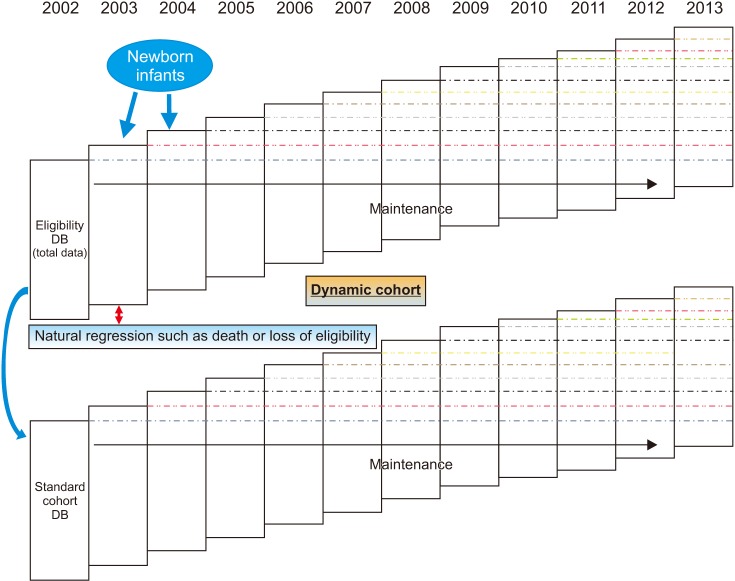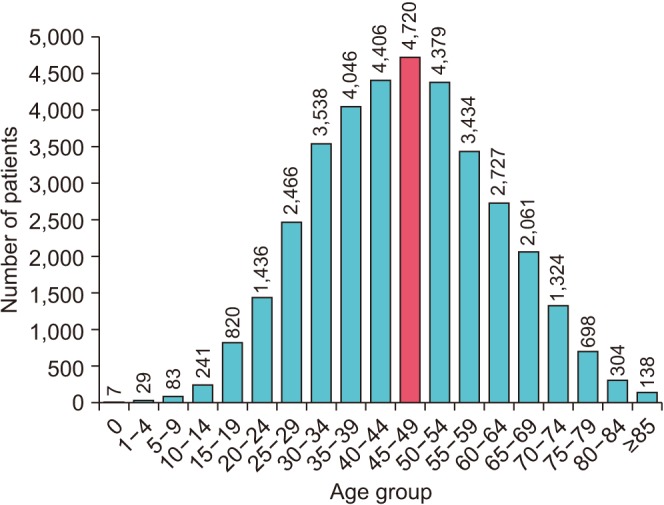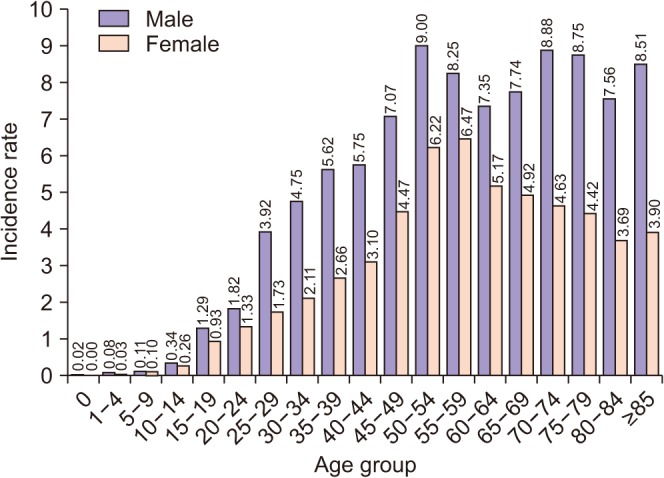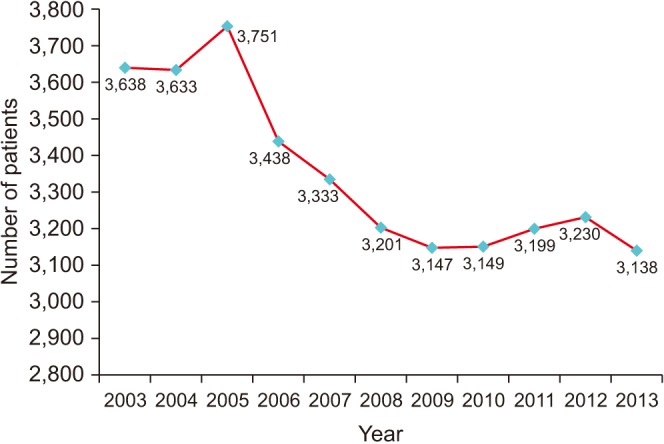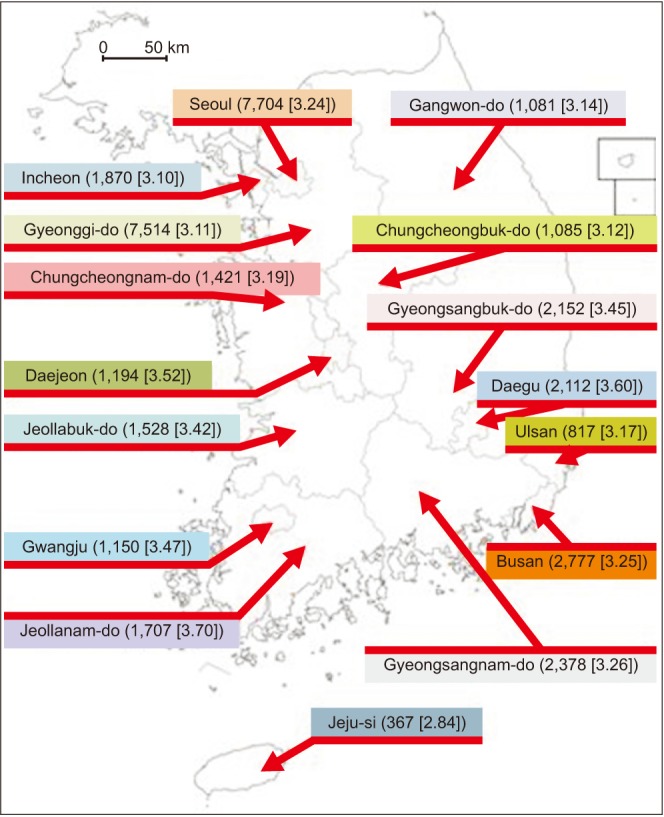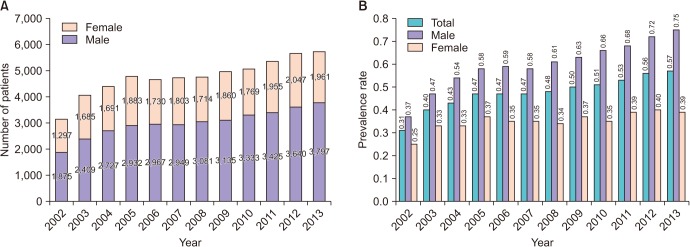Investig Clin Urol.
2018 Nov;59(6):383-391. 10.4111/icu.2018.59.6.383.
Study on the prevalence and incidence of urolithiasis in Korea over the last 10 years: An analysis of National Health Insurance Data
- Affiliations
-
- 1Department of Urology, Uijeongbu St. Mary's Hospital, The Catholic University of Korea, Uijeongbu, Korea. robinbae97@catholic.ac.kr
- KMID: 2424293
- DOI: http://doi.org/10.4111/icu.2018.59.6.383
Abstract
- PURPOSE
We aimed to analyze the incidence and prevalence of urolithiasis in Korea over the last decade using the National Health Insurance (NHI) sample cohort data.
MATERIALS AND METHODS
From January 2002 to December 2013, we enrolled sample cohort data from the NHI. Patients diagnosed with international classification of diseases code N20 or N13.2 were included. The incidence and prevalence rate was counted from the same period and patients previously diagnosed with urolithiasis were excluded. We compared the incidence and prevalence of urolithiasis by region, age, and sex, and identified the changes.
RESULTS
Total 1,111,828 subjects were included. Of these subjects, 36,857 had urolithiasis. The male-to-female ratio was 1.57:1, and total incidence rate was 3.27 per 1,000 person-years (1,000p-yrs). The annual incidence was lowest in 2013 (3,138 patients) and highest in 2005 (3,751 patients). Incidence rate by diagnostic code was highest in ureter stone only (2.49 per 1,000p-yrs) and was lowest in kidney and ureter stone both (0.17 per 1,000p-yrs). Prevalence gradually increased from 3,172 in 2002 and 5,758 in 2013. Jeollanam-do had the highest incidence rate of 3.70 persons per 1,000p-yrs, and Jeju had the lowest rate of 2.84 persons per 1,000p-yrs. In gender analysis, Daegu had the highest incidence (4.56) in males, Jeollanam-do had the highest incidence (3.20) in females.
CONCLUSIONS
Annual incidence remained stable, whereas prevalence gradually increased. The incidence in male was 1.57 times higher than female, and the peak incidence age was 45-49 years, with the highest incidence occurring in Jeollanam-do and the lowest in Jeju.
Keyword
MeSH Terms
Figure
Reference
-
1. Bryant M, Angell J, Tu H, Goodman M, Pattaras J, Ogan K. Health related quality of life for stone formers. J Urol. 2012; 188:436–440. PMID: 22704108.
Article2. Raheem OA, Khandwala YS, Sur RL, Ghani KR, Denstedt JD. Burden of Urolithiasis: trends in prevalence, treatments, and costs. Eur Urol Focus. 2017; 3:18–26. PMID: 28720363.
Article3. Kamel MH, Tao J, Su J, Khalil MI, Bissada NK, Schurhamer B, et al. Survival outcomes of organ sparing surgery, partial penectomy, and total penectomy in pathological T1/T2 penile cancer: report from the National Cancer Data Base. Urol Oncol. 2018; 36:82.e7–82.e15.
Article4. Antonelli JA, Maalouf NM, Pearle MS, Lotan Y. Use of the National Health and Nutrition Examination Survey to calculate the impact of obesity and diabetes on cost and prevalence of urolithiasis in 2030. Eur Urol. 2014; 66:724–729. PMID: 25015037.
Article5. Kim SH, Joung JY, Suh YS, Kim YA, Hong JH, Kuark TS, et al. Prevalence and survival prognosis of prostate cancer in patients with end-stage renal disease: a retrospective study based on the Korea national database (2003–2010). Oncotarget. 2017; 8:64250–64262. PMID: 28969067.
Article6. Bae SR, Seong JM, Kim LY, Paick SH, Kim HG, Lho YS, et al. The epidemiology of reno-ureteral stone disease in Koreans: a nationwide population-based study. Urolithiasis. 2014; 42:109–114. PMID: 24526235.
Article7. Kang HW, Seo SP, Ha YS, Kim WT, Kim YJ, Yun SJ, et al. Chronological trends in clinical and urinary metabolic features over 20 years in Korean urolithiasis patients. J Korean Med Sci. 2017; 32:1496–1501. PMID: 28776346.
Article8. Park J, Suh B, Lee MS, Woo SH, Shin DW. National practice pattern and time trends in treatment of upper urinary tract calculi in Korea: a nationwide population-based study. J Korean Med Sci. 2016; 31:1989–1995. PMID: 27822940.
Article9. Tae BS, Balpukov U, Cho SY, Jeong CW. Eleven-year cumulative incidence and estimated lifetime prevalence of urolithiasis in Korea: a National Health Insurance Service-national sample cohort based study. J Korean Med Sci. 2018; 33:e13. PMID: 29215822.
Article10. Modlin M. A history of urinary stone. S Afr Med J. 1980; 58:652–655. PMID: 6999641.11. Ansari MS, Gupta NP. Impact of socioeconomic status in etiology and management of urinary stone disease. Urol Int. 2003; 70:255–261. PMID: 12776701.
Article12. Bartoletti R, Cai T, Mondaini N, Melone F, Travaglini F, Carini M, et al. Epidemiology and risk factors in urolithiasis. Urol Int. 2007; 79(Suppl 1):3–7. PMID: 17726345.
Article13. Ferrari P, Piazza R, Ghidini N, Bisi M, Galizia G, Ferrari G. Lithiasis and risk factors. Urol Int. 2007; 79(Suppl 1):8–15.
Article14. Trinchieri A. Epidemiological trends in urolithiasis: impact on our health care systems. Urol Res. 2006; 34:151–156. PMID: 16440192.
Article15. Stamatelou KK, Francis ME, Jones CA, Nyberg LM, Curhan GC. Time trends in reported prevalence of kidney stones in the United States: 1976-1994. Kidney Int. 2003; 63:1817–1823. PMID: 12675858.16. Indridason OS, Birgisson S, Edvardsson VO, Sigvaldason H, Sigfusson N, Palsson R. Epidemiology of kidney stones in Iceland: a population-based study. Scand J Urol Nephrol. 2006; 40:215–220. PMID: 16809263.
Article17. Yasui T, Okada A, Hamamoto S, Hirose M, Ando R, Kubota Y, et al. The association between the incidence of urolithiasis and nutrition based on Japanese National Health and Nutrition Surveys. Urolithiasis. 2013; 41:217–224. PMID: 23632912.
Article18. Turney BW, Reynard JM, Noble JG, Keoghane SR. Trends in urological stone disease. BJU Int. 2012; 109:1082–1087. PMID: 21883851.
Article19. Knoedler JJ, Krambeck AE, Astorne W, Bergstralh E, Lieske J. Sex steroid hormone levels may not explain gender differences in development of nephrolithiasis. J Endourol. 2015; 29:1341–1345. PMID: 26422682.
Article20. Maalouf NM, Sato AH, Welch BJ, Howard BV, Cochrane BB, Sakhaee K, et al. Postmenopausal hormone use and the risk of nephrolithiasis: results from the women’s health initiative hormone therapy trials. Arch Intern Med. 2010; 170:1678–1685. PMID: 20937929.
Article21. Park HA, Park JK, Park SA, Lee JS. Age, menopause, and cardiovascular risk factors among Korean middle-aged women: the 2005 Korea National Health and Nutrition Examination Survey. J Womens Health (Larchmt). 2010; 19:869–876. PMID: 20350203.
Article22. KOSIS. Population by age and sex Korean statistical information service 2016 [Internet]. Daejeon: KOSIS;2017. 8. 31. cited 2018 Apr 30. Available from: http://kosis.kr/statHtml/statHtml.do?orgId=101&tblId=DT_1IN1603&conn_path=I2.23. Park YH, Chung SJ. A comparison of sources of sodium and potassium intake by gender, age and regions in Koreans: Korea National Health and Nutrition Examination Survey (KNHANES) 2010-2012. Korean J Community Nutr. 2016; 21:558–573.
Article24. Gaziev G, Asimakopoulos AD, Wadhwa K, Topazio L, Germani S, Miano R. The influence of environmental conditions on the incidence of renal colic in Rome. Urologia. 2016; 83:77–82. PMID: 27103092.
Article25. Park HK, Bae SR, Kim SE, Choi WS, Paick SH, Ho K, et al. The effect of climate variability on urinary stone attacks: increased incidence associated with temperature over 18℃: a population-based study. Urolithiasis. 2015; 43:89–94. PMID: 25407800.26. KMA. Mean temperature, daily precipitation, mean relative humidity in Seoul & Jeju National Climate Data Service System 2016 [Internet]. Seoul: KMA;2016. cited 2018 Apr 30. Available from: http://sts.kma.go.kr/jsp/home/contents/statistics/newStatisticsSearch.do?menu=SFC&MNU=MNU.27. Eisner BH, Sheth S, Herrick B, Pais VM Jr, Sawyer M, Miller N, et al. The effects of ambient temperature, humidity and season of year on urine composition in patients with nephrolithiasis. BJU Int. 2012; 110:E1014–E1017. PMID: 22578009.
Article28. Dallas KB, Conti S, Liao JC, Sofer M, Pao AC, Leppert JT, et al. Redefining the stone belt: precipitation is associated with increased risk of urinary stone disease. J Endourol. 2017; 31:1203–1210. PMID: 28830242.
Article29. Ryu HY, Lee YK, Park J, Son H, Cho SY. Dietary risk factors for urolithiasis in Korea: a case-control pilot study. Investig Clin Urol. 2018; 59:106–111.
Article
- Full Text Links
- Actions
-
Cited
- CITED
-
- Close
- Share
- Similar articles
-
- Epidemiology of Urolithiasis with Sex and Working Status Stratification Based on the National Representative Cohort in Republic of Korea
- Eleven-year Cumulative Incidence and Estimated Lifetime Prevalence of Urolithiasis in Korea: a National Health Insurance Service-National Sample Cohort Based Study
- Utilization of health insurance data in an environmental epidemiology
- The Prevalence and Incidence of Parkinson's Disease in South Korea: A 10-Year Nationwide Population: Based Study
- Analyzing Treatment Patterns for Neovascular Age-related Macular Degeneration with Expansion of the Korean Health Insurance Policy

